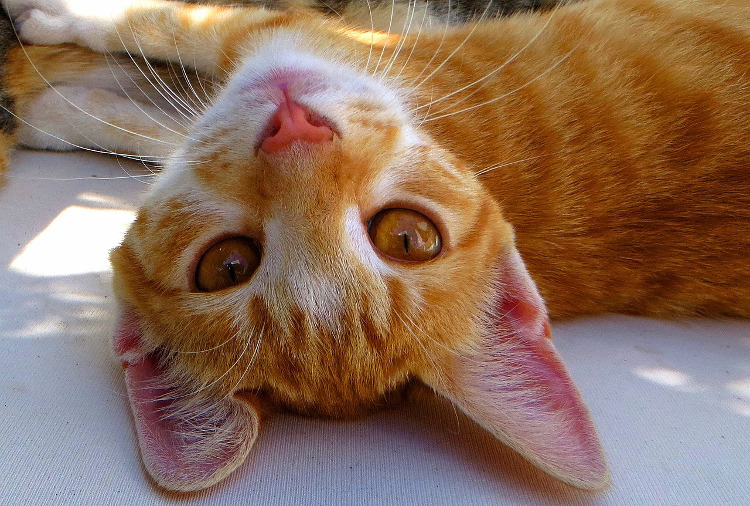![]()
Perhaps you find your cat scratching at their ears a bit more than usual and it seems like they may have some symptoms of ear problems. If you’re suspecting your cat has any type of ear issue, it may be time to take them to your veterinarian. If your veterinarian needs help or believes that a visit to the pet dermatologist is a good idea, they can refer you to a veterinary dermatologist. Some ear problems in your feline friend would benefit from the expertise provided by veterinary dermatologists in helping diagnose and treat the ear condition.
Signs to Seek Help
If you find your kitty exhibiting any of these symptoms, get them in to see a vet right away:
- Scratching and pawing excessively at their ears and head
- Sensitivity to the ears upon being touched
- Tilting their head
- Shaking their head frequently
- Disorientation and balance problems
- Outer ear and/or ear canal seems to be red and swollen
- Foul odour
- Black or yellowish discharge or dark brown wax
- Some hearing loss
- Ear bleeding
- Behavioural changes such as depression or irritability
Some ear problems that can cause the above symptoms are listed below.
Ear Mites
While there are over-the-counter medications you can get for the condition, it is best to get a confirmed diagnosis before treatment. Your vet can flush your cat’s ears gently and properly diagnose and treat this issue. Ear mites (scientific name: Otodectes cyanotis) are tiny parasites that live in and around the ears. They can be easily passed between cats, but are most common among kittens.
You might suspect your cat has mites if you see them shake their heads and scratch around their ears, head and neck. If you see tiny coffee ground looking specks in their ears, it may be suggestive of an ear mite problem. Live ones look like white moving specs the size of a pin head; you might need a magnifying glass to try and see them.
Ear Canal Infections
Bacterial and yeast outer ear canal infections (otitis externa) can look like that of ear mite infestations with similar symptoms, but a closer look by a professional will reveal the difference. As ear canal infections are almost always secondary to another underlying problem, it is important to find out the underlying cause of the infection, or it is likely to reappear sooner or later.
Your vet can microscopically examine samples taken to determine whether the problem is yeast or bacterial, as well as thoroughly clean your cat’s ears. They can determine how much and what kind of damage has been done to the ears, then prescribe appropriate treatments such as ear cleaners and medications.
Middle Ear Infections
Middle ear infections are quite bothersome and difficult to treat as the infection may have travelled past the ear drum and in to the middle ear. This is a tough area to treat and often animal dermatologist may be needed. If an ear infection keeps recurring in one or both ears despite adequate treatment, it is usually time to pursue a thorough deep ear examination in order to confirm that the middle ear and ear drum are in good health. If not, it may be time to treat for a middle ear infection, also called otitis media. Video-otoscopy (a small camera used to check deep ear structures) is a helpful tool in such cases.
Inflammatory Ear Polyp
An ear polyp is an inflammatory mass that can grow within the deep ear canal leading to discomfort in an ear as well as recurrent ear infections, despite adequate treatment. The signs can be similar to a middle ear infection but upon deep evaluation using video-otoscopy, a mass may be found. Luckily, these masses are not cancerous and can be carefully removed using specialized tools through the video-otoscope equipment. Once the treatment is done, cats feel comfortable and go back to being their happy selves.
Sarcoptic Mange
Mange is rare in cats and is an inflammatory skin problem caused by mites that are invisible to the naked eye. These mites, or Notoedres cati, prefer to live on the skin around the head and ears.
This parasite infestation can make cats so itchy that they scratch themselves to the point of self-injury. The skin in affected areas can become thickened, scaly, and covered with crusts.
If you suspect your cat has mange be sure to book a veterinary check up including an examination of any other pets you own as it’s highly contagious between animals! Your vet may require skin samples to examine under a microscope and identify the type of mite affecting your kitty in order to provide proper treatment options.
Allergies
Any type of allergies your cat may have, whether it’s environmental, food-related, or parasite-related, can result in itchiness of the ears and head. Your vet can help determine the underlying cause of allergies and prescribe proper treatment. Veterinary dermatologists specialize in diagnosis and treatment of allergies and can help pin point the cause of the itchiness. Pet skin specialists are also the ear specialists for cats as ears are an extension of the skin.
Any ear problems you suspect your kitty may have should be immediately treated by family veterinarian or a veterinary dermatologist. Early intervention and treatment is the best way to keep your cat comfortable and happy!
Creative Commons Attribution: Permission is granted to repost this article in its entirety with credit to VetDERM Clinic and a clickable link back to this page.

Dr. Jangi Bajwa is a Board certified veterinary dermatologist at VetDERM Clinic in Surrey BC. He is also the dermatology feature editor for Canadian Veterinary Journal. Dr. Bajwa’s special interests include otitis and allergic disease in pets; as well as helping improve quality of life of pets and their families.



 by
by